External links
| This United States Army article is a stub. You can help Wikipedia by expanding it. |
The Logistics Proponency Office (formerly the Office of the Chief of Transportation) is the personnel office for the Transportation Corps, the combat service support of the United States Army.
Located at Fort Eustis in Virginia, the Office is a General officer-level command that, in conjunction with the Human Resources Command and United States Transportation Command manages career progression for civilians, officers, warrant officers, and enlisted soldiers serving in transportation and logistics roles for the Army.
The explicit mission of the Office is the structuring, acquiring, training and educating, distributing, deploying, sustaining, professionally developing, and separating of personnel; policy coordination toward those ends exists between the Office and United States Army Training and Doctrine Command and the United States Army Combined Arms Support Command, as the Office is the principal Army command responsible for offering a proponency perspective on proposed personnel and structure decisions relative to the Transportation Corps and to Transportation Corps soldiers serving in the United States National Guard and United States Army Reserve.
The Office additionally manages the Marine Qualification Division and sea pay programs of the Army and registers vessel names in support of each of the two programs.
| This United States Army article is a stub. You can help Wikipedia by expanding it. |

Military ranks are a system of hierarchical relationships in armed forces, police, intelligence agencies or other institutions organized along military lines. The military rank system defines dominance, authority, and responsibility in a military hierarchy. It incorporates the principles of exercising power and authority into the military chain of command – the succession of commanders superior to subordinates through which command is exercised. The military chain of command constructs an important component for organized collective action.
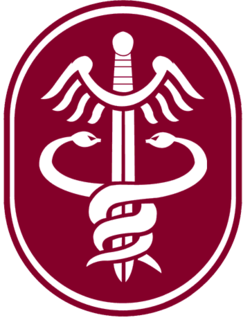
The U.S. Army Medical Command (MEDCOM) is a direct reporting unit of the U.S. Army that formerly provided command and control of the Army's fixed-facility medical, dental, and veterinary treatment facilities, providing preventive care, medical research and development and training institutions. On 1 October 2019, operational and administrative control of all military and veteran medical facilities transitioned to the Defense Health Agency.

The United States Army Reserve (USAR) is a reserve force of the United States Army. Together, the Army Reserve and the Army National Guard constitute the Army element of the reserve components of the United States Armed Forces.
Fort Eustis is a United States Army installation in Newport News, Virginia. In 2010, it was combined with nearby Langley Air Force Base to form Joint Base Langley–Eustis.

Established 1 July 1973, the United States Army Training and Doctrine Command (TRADOC) is a major command of the United States Army headquartered at Fort Eustis, Virginia. It is charged with overseeing training of Army forces and the development of operational doctrine. TRADOC operates 37 schools and centers at 27 different locations. TRADOC schools conduct 1,304 courses and 108 language courses. The 1,304 courses include 516,000 seats for 443,231 soldiers; 36,145 other-service personnel; 8,314 international soldiers; and 28,310 civilians.

The Transportation Corps was established 31 July 1942 by Executive Order 9082. The Transportation Corps is a combat service support branch of the U.S. Army, and was headquartered at Fort Eustis, Virginia, but moved to Fort Lee, Virginia in 2010. It is also one of three U.S. Army logistics branches, the others being the Quartermaster Corps and the Ordnance Corps. The Transportation Corps is responsible for the movement of personnel and material by truck, rail, air, and sea. Its motto is "Spearhead of Logistics," and it is currently the second-largest branch of the Army.

The United States Army Quartermaster Corps, formerly the Quartermaster Department, is a Sustainment, formerly combat service support (CSS), branch of the United States Army. It is also one of three U.S. Army logistics branches, the others being the Transportation Corps and the Ordnance Corps.
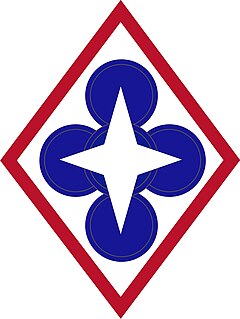
The U.S. Army Combined Arms Support Command (CASCOM), a major subordinate command of the Training and Doctrine Command (TRADOC), is located at Fort Lee, Virginia. Underneath CASCOM Headquarters is the Sustainment Center of Excellence (SCoE).
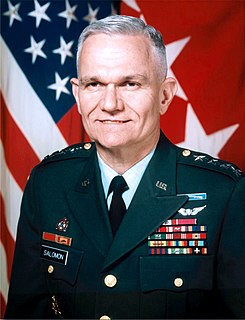
General Leon E. Salomon was born in Chicago, Illinois, on 27 April 1936. On completion of Infantry Officer Candidate School he was commissioned a second lieutenant in 1959. General Salomon has Bachelor of Science degree in chemistry and biology from the University of Florida and a Master of Science degree in management logistics from the U.S. Air Force Institute of Technology. His military education includes the Chemical Officer Advanced Course, the U.S. Army Command and General Staff College, and the Industrial College of the Armed Forces.

The Oklahoma Military Department is an agency of the state of Oklahoma that serves as the administrative agency for all matters concerning the Oklahoma National Guard. Under the authority and direction of the Governor of Oklahoma as commander-in-chief, the agency is responsible for planning, establishing, and enforcing rules and procedures governing the administration, supply, and training of the Oklahoma National Guard, when not in the active service of the United States, the Oklahoma State Guard and the Oklahoma Unorganized Militia. The Department also maintains all state-owned, licensed or leased facilities, including Camp Gruber.

The Naval Supply Systems Command (NAVSUP) is a command of the United States Navy.

The structure of the United States Army is complex, and can be interpreted in several different ways: active/reserve, operational/administrative, and branches/functional areas.
The Office of the United States Assistant Secretary of the Army for Acquisition, Logistics, and Technology is known as OASA(ALT). OASA(ALT) serves, when delegated, as the Army Acquisition Executive, the Senior Procurement Executive, the Science Advisor to the Secretary of the Army, and as the senior research and development official for the Department of the Army. The OASA(ALT) also has the principal responsibility for all Department of the Army matters related to logistics.
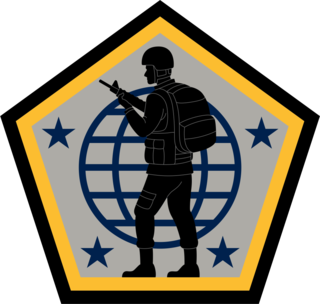
The United States Army Human Resources Command is a command of the United States Army established in 2003 from the merger of the United States Total Army Personnel Command (PERSCOM) in Alexandria, Virginia and the United States Army Reserve Personnel Command (AR-PERSCOM) in St. Louis, Missouri. PERSCOM and AR-PERSCOM were inactivated 1 October 2003.
The Adjutant General School and the Soldier Support Institute (SSI) are located at Fort Jackson, South Carolina. These provide training and development of doctrine and organization for Army personnel and administrative operations. Along with the U.S. Army Forces Command (FORSCOM), United States Army Training and Doctrine Command (TRADOC) was created from the Continental Army Command (CONARC) located at Fort Monroe, VA on 1 July 1973. Today, TRADOC is the overseer of training of the Army forces, the development of operational doctrine, and the development and procurement of new weapons systems. The reconstructed Adjutant General Corp Regiment (AG) was created in 1987. The U.S. Army administration and finance specialists are trained at the Adjutant General School located at Fort Jackson. Today's AG Corps serves as human resource (HR) managers for the Army.

The Adjutant General's Corps, formerly the Adjutant General's Department, is a branch of the United States Army first established in 1775. This branch is responsible for providing personnel service support by manning the force, providing human resources services, coordinating personnel support, Army band operations, and recruiting and retention. The objective of the Adjutant General Corps is to "maximize operational effectiveness of the total force by anticipating, manning, and sustaining military operations. HR support operations accomplish this by building, generating, and sustaining the force providing combatant commanders the required forces for missions and supporting leaders and Soldiers at all levels."

Larry Wyche, is a retired United States Army Lieutenant General. He last served as the deputy commanding general of the U.S. Army Materiel Command. Prior to his last assignment, Wyche served as the Special Assistant to the Commanding General, U.S. Army Training and Doctrine Command. He has also served as commanding general of the Combined Arms Support Command, commanding general of the Sustainment Center of Excellence (SCoE) and Senior Mission Commander for Fort Lee, Virginia.
"We are Warfighter Logisticians and Supporters, prepared to give the shirts off our backs and boots off our feet, to support the fight. We will never say no, as long as there is one gallon of gas to give, or one bullet to give"

The Chief of Ordnance of the United States Army is a general officer who is responsible for the U.S. Army Ordnance Corps and serves as the Commandant of the U.S. Army Ordnance School at Fort Lee, Virginia. The Chief of Ordnance is primarily focused on the doctrine, training, and professional development of Ordnance officers and soldiers. The position was created simultaneously with the establishment of the U.S. Army Ordnance Department on May 14, 1812.
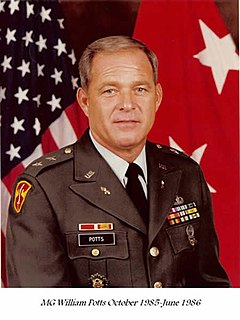
Major General William Estel Potts was a career officer in the United States Army and served as the 22nd Chief of Ordnance for the U.S. Army Ordnance Corps.
The Indonesian Army Logistics and Transportation Corps is a sustainment – formerly combat service support (CSS) – agency of the Indonesian Army. Its primary missions are supporting the development, production, acquisition, and sustainment of general supply, mortuary affairs, subsistence, petroleum and water, material and distribution management during peace and war and in support of civil disaster relief. It is also tasked with providing combat logistics and equipment, personnel and materiel transport services over any terrain on land, rail, air and sea in coordination with the other service branches of the Indonesian National Armed Forces.